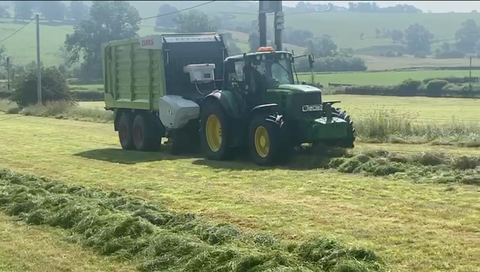How to Interpret Silage Analysis
Silage analysis can provide an idea of the contents of the silage, but it cannot present how the rumen will respond to the forage. This means that silage analysis cannot predict silage performance.
There are many factors which affect how silage will feed such as a high pH, high dry matter, good ME, digestibility, and protein. However, due to the high dry matter and pH, it’s likely that the silage will not be stable and could be predisposed to heating and mould. In cattle, these factors will reduce intakes and a mycotoxin binder may need to be fed.
What Can Silage Analysis Be Used For?
Although silage analysis is a helpful tool, the results can vary due to silage being changeable. Different areas of the clamp will have different quality silage, for example, grass near walls will have poorer consolidation.
Fields also vary in quality, with recent reseeds often having a higher yield of ME and D-value silages. It is common for soil in fields to be contaminated which can compromise the quality. Although it is important to sample across the face, it is not possible to achieve a fully representative sample from one analysis.

What Can Silage Analysis Find?
Dry matter
Dry matter is the amount of silage when the water is removed, the ideal silage dry matter being between 25%-35%. Dry matter also had a significant influence on intake.
Metabolisable Energy (ME)
ME is the energy content of the silage after losses within the animal. When the value of the ME is higher, the quality of the silage increases, however, stemmier-headed plants at silage time cause the ME levels to become low.
D-value
The D-value of silage is digestibility; like ME, it is linked to the maturity of grass when it’s cut. A high value is best, with a respectable D-value being above 65.
Crude Protein
Crude protein is the amount of protein in the silage, including any residual nitrogen from fertilisers. Low protein silage will need supplementation as stock may struggle to utilise all the protein in high protein silage. The target of crude protein is 11-15%, if it is below or above this figure there is a chance of high milk urea and poor fertility.
pH
An excessively low pH could lead to low intakes and acidosis problems. Equally, a high pH is undesirable, it generally indicating poor grass fermentation or secondary fermentation. This could mean the silage is susceptible to heating and mould.
What Is Silage Analysis Not Appropriate For?
Silage analysis doesn’t consider clamp or silage characteristics or how they will impact the feeding potential. Larger clamps with bigger faces will be impacted by the weather as well as exposure to the air, causing them to spoil faster.
Silage Analysis in Cattle
When considering silage characteristics, chop length will have more of an impact on fermentation within the cow than stated in the analysis. The best silage analysis is given by the cow itself, which helps to identify how the diet may be tweaked to maximise rumen function and optimise yield.

